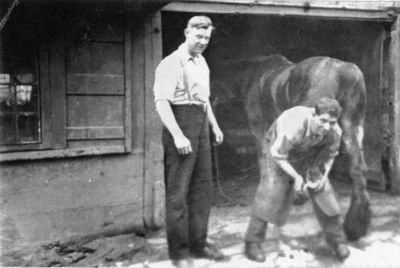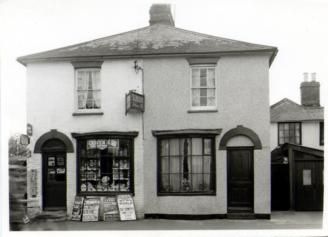A Walk Down Memory Lane,
Greenstreet 1940
It is mid-September, 1940; there is not a cloud in the sky, and the war seems a million miles away. It is calm and peaceful so we have decided to take a slow saunter down through the Village, so why not come and join us. We will stay on the Lynsted side of the Street and endeavour, memory permitting, to recall the properties and local characters around at the time.
 We leave Cellar Hill at “The Walnuts” and turn left onto the A.2. Immediately we hear the sound of ringing metal and see Mr Frank Seal forging new shoes for two of Mr Percy French’s large cart horses. These magnificent beasts can be seen waiting patiently outside in the care of Waggoner Wally Tumber, flat cap on the back of his head mopping his brow. After having a friendly chat we move off passing Mr. Thomas’s imposing house and the row of small terraced houses, leading to the “Grange”. It is here that the local Scout Group under the watchful eye of the Group Leader, the Reverend Williams, has its “Activity Den” in an outside building, by kind permission of the owner, Mr Bull. Adjoining the “Grange” is the “Dover Castle” that today is relatively quiet as it is early morning. We try the door marked “Bottle & Jug” but find it locked. Interestingly we bump into two RAF men who have parked their “Queen Mary”, a 60ft. long aircraft recovery vehicle, on the opposite side of the road, whilst they used the Pub’s outside toilet. On chatting we learn that they are on their way to recover the remains of a crashed Hurricane fighter that came down the previous day at Oare, the pilot escaping unhurt. There is not a vehicle of any description to be found in the car park.
We leave Cellar Hill at “The Walnuts” and turn left onto the A.2. Immediately we hear the sound of ringing metal and see Mr Frank Seal forging new shoes for two of Mr Percy French’s large cart horses. These magnificent beasts can be seen waiting patiently outside in the care of Waggoner Wally Tumber, flat cap on the back of his head mopping his brow. After having a friendly chat we move off passing Mr. Thomas’s imposing house and the row of small terraced houses, leading to the “Grange”. It is here that the local Scout Group under the watchful eye of the Group Leader, the Reverend Williams, has its “Activity Den” in an outside building, by kind permission of the owner, Mr Bull. Adjoining the “Grange” is the “Dover Castle” that today is relatively quiet as it is early morning. We try the door marked “Bottle & Jug” but find it locked. Interestingly we bump into two RAF men who have parked their “Queen Mary”, a 60ft. long aircraft recovery vehicle, on the opposite side of the road, whilst they used the Pub’s outside toilet. On chatting we learn that they are on their way to recover the remains of a crashed Hurricane fighter that came down the previous day at Oare, the pilot escaping unhurt. There is not a vehicle of any description to be found in the car park.
Let’s pause here for a while and advance the years to the end of the war. The picture would be entirely different. The car park would have been full of Charabancs containing Londoners who had stopped for refreshments on their return from a day at the seaside. Us local lads would congregate round them chanting “Throw out your mouldy pennies” whereupon the visitors would take great delight in watching us scrambling and fighting for the few coppers available.

"Popes" shop
Back to 1940 and we move by the two houses next to the car park occupied by Mrs Smith and Mrs Baker from whom you could buy chicken eggs for one halfpenny, and reach “Popes” the newsagent and tobacconists. We pluck up courage to enter to enquire if there are any out-of-date comics to be had such as The Beano, Dandy, Hotspur, Film Fun, Mickey Mouse or any other. If lucky and on a good day we might be given a free small “Sharps” toffee bar to share between us. Next door is “Tinker” Watts hardware store, that faces directly down Teynham Lane. The shop is just opening for business and “Tinker” can be seen, dressed in his brown overall, removing the black-out curtains from his front windows; two prospective customers, bicycles parked at the kerbside, are waiting to enter. Joined to the store is the small house with a neat and tidy fenced garden occupied by Mrs Roberts. Passing a row of small terraced houses, set well back from the road, we come across “Barney Wilkins” butchers shop.
Local housewives are beginning to queue for their weekly ration of meat allotted to them through coupons in their ration books and hopefully a little extra. Turning up at the entrance to the side of the butchers we reach the orchard where a local character lives in a small shack. We know this gentleman as ”Kruschens” and he would when prompted relate many a tale of his wanderings round the world. He was a much travelled and intelligent man who would be seen most mornings cycling to Conyer to take his swim, irrespective of the weather conditions.
We now pass some more terraced houses, albeit more substantially built than those previously seen, the end of one of these being occupied by Courts, the tailors. Here works Mr Tom Moore, usually known as “Stitch”, who spends a great deal of his time tailoring for the local gentry. Adjoining is a small bow-fronted shop, Pilcher’s sweet shop. Today we hurriedly pass by as funds are low but we take the time to study the mouth-watering display of confectionery in the large glass jars arranged on the wooden shelves. After passing two older type houses set back from the road, we reach the bus stop. At this precise moment a No. 26 Maidstone and District green double deck bus, on its way from Faversham to Gravesend, pulls in to allow a few passengers to alight and some to board.
As the conductor rings the bell signalling the bus to move off, a now familiar sound is heard coming from the rear of the “George Inn”. It is the air raid siren announcing the imminent arrival of the German Air Force passing over on its way to bomb London. Soon the drone of approaching aircraft is heard and we look up to see many bombers escorted by fighters; our morning peace is shattered. The bus pulls up, as is required by war time law, to the brick and concrete air raid shelter adjoining the “George” to allow its passengers and crew to enter it for their safety. They must remain here until the “All Clear” siren is sounded. It is at this point that we experience a period of excitement for us as the Luftwaffe is engaged by British fighter aircraft. Dogfights begin and against all commonsense and with disregard for our own safety, we watch the ensuing battle, seeing contrails in the sky left by the higher positioned planes, parachutes carrying airmen to safety and hoping the aircraft seen crashing are all German. We hear later that one of the British fighters, a Hurricane, has crashed at Nouds Farm, killing the pilot. Today there is a special memorial placed on the site, and a yearly service held in September to commemorate the event. The air battle moves away and calm once again prevails. The “All Clear” sounds and the passengers and crew emerge from the shelter to board the bus which proceeds on its way, albeit later than scheduled.
It is now midday and suddenly the street fills with farm workers cycling their way home to lunch. We pause here as a rumbling can be heard in the distance. We look down towards the “Fox Inn” to see an Army Convoy approaching the village, preceded by two dispatch riders on motor cycles that are there to ensure that the road is clear of obstructing vehicles. We learn later that the two 3.7 inch anti-aircraft guns in the convoy are to be sited in Norton Park as part of the Home Counties defence against German bombers approaching London. We proceed on our way passing the large house on the corner of Lynsted Lane occupied by Mrs Roberts, cross the lane and pass both the “George” and “Swan”. These are both quiet and short of customers.
Thomsett’s, the wet fish shop, is the next building we come to before reaching the passage way that leads to the slaughter house which we are forbidden to enter, although we occasionally see cattle being driven along the road going to the house. Across the passageway is Thomsett’s radio and electrical shop. Here we are reminded that our wireless accumulators should be ready for collection after being charged. There’s nothing so infuriating than when an accumulator fades during a radio news broadcast, especially when it occurs during the evening. We pass Wilkins, the butchers shop, and arrive at Jack Kemsley’s shoe and boot repair shop which we enter for a friendly chat. He carries on working, resoling a pair of shoes needed later that day. Adjoining is a small shoe shop run by Jack’s sister Myra, at the moment without any customers.
Pausing here we feel that we have covered enough ground for one day and must leave the remainder of our saunter for later.
Bernard Cork.